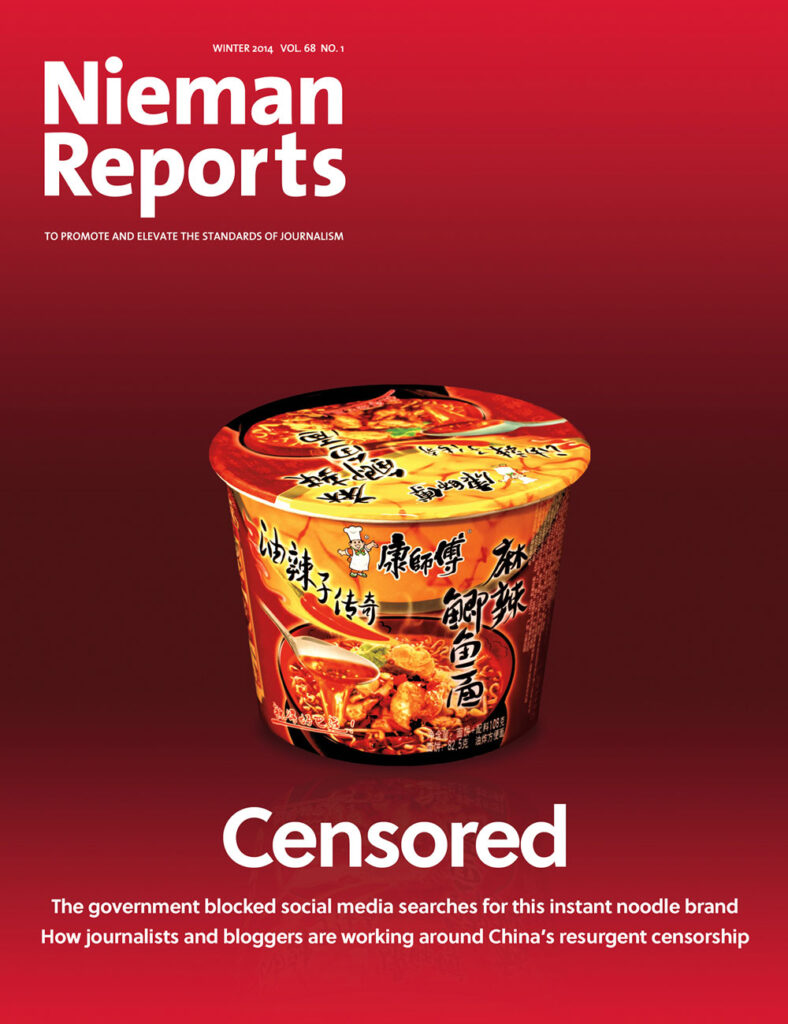In the fall of 2013, the U.S. National Security Agency (NSA) quietly began booting up its Utah Data Center, a sprawling 1.5 million-square-foot facility designed to store and analyze the vast amounts of electronic data the spy agency gathers from around the globe. Consisting of four low-slung data halls and a constellation of supporting structures, the facility includes at least 100,000 square feet of the most advanced data reservoirs in the world. The project represents a massive expansion of the NSA’s capabilities and a profound threat to press freedom worldwide.
The data center is but the most obvious example of a future in which governments may not only collect and parse enormous quantities of data, but also store it for increasingly longer periods of time. It could soon be possible to uncover sources with such ease as to render meaningless any promise of confidentiality a journalist may attempt to provide—and if an interaction escapes scrutiny in the first instance, it could be reconstructed later. As long-term storage rapidly becomes less expensive, it will fall within the grasp of authoritarian regimes whose track records on press freedom afford little hope for restraint.
In addition to amplifying the harms caused by pervasive surveillance, the storage of data creates another, unique potential: it provides a deep breeding ground for artificial intelligence systems. As these capabilities evolve, governments will be able to spot patterns of terrorist activity, or journalistic activity, long before either becomes a challenge to their power. If left unchecked, surveillance systems may fail to draw such distinctions.
Given the NSA’s secretiveness, reporting on the agency often becomes an exercise in careful conjecture. Leaked documents from former NSA contractor Edward Snowden have shed some light on the agency’s activities. William Binney, considered one of the best mathematicians and code breakers at the NSA until his resignation in 2001 in protest of the mass privacy violations he alleges the agency committed after the 9/11 attacks, says journalists are “a much easier, smaller target set” to spy on than the wider population. National security journalist James Bamford, whom The New Yorker dubbed “The NSA’s Chief Chronicler,” believes certain journalists get extra scrutiny. “If you’re writing about national security or the NSA itself,” he said, “they consider you—a journalist—a national security danger, and so they feel justified in doing whatever they’re doing.”
Alex Abdo, an American Civil Liberties Union attorney, is part of a team of lawyers who have litigated against the NSA for violating the privacy and free speech rights enshrined in the U.S. Constitution. He believes that “all reporters should be worried,” though perhaps for different reasons. “Reporters who work for the largest media organizations should be worried probably primarily because their sources will dry up as those sources recognize that there is no way to cover their trail” when they talk to journalists at The New York Times, The Washington Post, or The Wall Street Journal. For independent journalists, by contrast, the primary concern is that “they themselves will be swept up in the course of their reporting, because they don’t enjoy some of the institutional protections that journalists get when they work at the bigger organizations.”
Asked about surveillance of journalists, the NSA asserted that the primary function of its data collection is to protect the U.S. from foreign threats. Spokeswoman Vanee’ Vines, herself a former investigative journalist, says, “NSA is focused on discovering and developing intelligence about valid foreign intelligence targets in order to protect the nation and its interests from threats such as terrorism and the proliferation of weapons of mass destruction.” (Intelligence officials have in the past misled the public about the NSA’s activities. At a March 2013 Senate Intelligence Committee hearing, Senator Ron Wyden asked Director of National Intelligence James Clapper, “Does the NSA collect any type of data at all on millions or hundreds of millions of Americans?” Clapper said, “No sir … not wittingly.” After Snowden’s revelations about the mass collection of Americans’ phone call records, and facing accusations of perjury from members of Congress, Clapper sent a letter to the committee chairwoman, Senator Diane Feinstein, apologizing for his “clearly erroneous” remarks under oath.)
In August 2013 the German magazine Der Spiegel reported that it had reviewed NSA documents, provided by Snowden, showing that the agency hacked into a “specially protected” internal communication system at the Qatar-based broadcaster Al Jazeera. According to Der Spiegel, the NSA documents listed the operation as “a notable success.” The NSA has not publicly commented on the report.
As the government stores more and more data, it will become next to impossible to keep sources confidential. The dangers are further compounded for non-U.S. journalists
One journalist for whom surveillance apparently has had direct and recent consequences is the award-winning documentary filmmaker Laura Poitras, whose films showcase American policy in the post-9/11 era and who, with Glenn Greenwald, documented Snowden’s revelations about the NSA in The Guardian. Poitras says she was detained for questioning at U.S. border crossings more than 40 times between 2006 and 2012.
Most journalists will probably not end up in the NSA’s crosshairs. But all journalists need to recognize that the agency is collecting immense amounts of information, that it will continue to develop this capacity, and that once collected, this information can be retained and put to broad use.
Former NSA staffer Binney says the NSA is mapping individuals’ lives, particularly their social and business connections, via the trail of digital “metadata” attendant with day-to-day existence. Though generally considered to exclude the contents of communications, and often transactional or descriptive in nature, metadata can be exquisitely detailed, as illustrated by a top secret order from the secretive U.S. Foreign Intelligence Surveillance Court (known as the FISA court) leaked to The Guardian by Snowden. According to the order, the NSA collects the numbers, location data, unique identifying information, and the time and duration of phone calls, for all parties. As reported by The New York Times, the FISA court has also authorized and re-authorized the collection and analysis of all Americans’ call records, regardless of any connection to a foreign agent.
Though judicial attitudes toward the privacy implications of metadata surveillance may slowly be shifting, as judges have begun to recognize its power to open up the lives of individuals to scrutiny, at present such data remains largely unprotected by the U.S. Fourth Amendment—meaning that even American journalists lack a so-called “reasonable expectation of privacy” for large amounts of their information.
The information gleaned from the aggregation of metadata records can build a remarkably intimate picture of one’s life. As computer security expert Bruce Schneier wrote on his blog in September 2013, metadata analysis is the equivalent of hiring a private detective to keep tabs on a person’s activities and associations. “The result would be details of what he did: where he went, who he talked to, what he looked at, what he purchased—how he spent his day,” Schneier wrote. “That’s all metadata.”
Metadata surveillance is particularly dangerous to journalists because it means the government can quickly pinpoint their sources. NSA chronicler Bamford says this has a “very serious effect” on investigative journalism. “If they’re able to see all the numbers you’re calling, they’re able to tell pretty much what kind of story you’re working on, even without getting the content of it. They’re able to tell what the nature of the story is, who the sources are you’re dealing with.”

The NSA, Binney says, is “building more and more storage because they’re collecting more and more data. The NSA will “take everything” off communication lines “and store it” for perhaps half a million to a million targeted individuals. According to Binney, the content information will then be indexed to the graph of lives and social networks. The agency can then query a timeline of an individual’s relationships over a period of time and “go straight into the content” indexed to each event. Binney’s estimate is that the NSA has both content and metadata going back a dozen years, and that this will only grow over time.
The extent to which the NSA may lawfully gather, store, and disseminate the contents of communications about U.S. persons is more closely constrained by the Fourth Amendment, as well as by statutes such as the 2008 FISA Amendments Act and other regulations, than is metadata. Nonetheless, there are numerous ways for the NSA to harvest the contents of communications of American journalists. The New York Times reported in August 2013 that the NSA is copying and searching the contents of large amounts of Americans’ cross-border communications, for the purpose of uncovering even mentions of small details—an email address, for example, or a nickname—about a foreigner under surveillance. Additionally, under current regulations, incidentally-acquired communications of Americans can be retained for up to six years to analyze whether they contain foreign intelligence information and/or evidence of a crime, according to recently declassified documents and reporting by The Washington Post and The Guardian. (Encrypted communications may be kept indefinitely, documents leaked to The Guardian reveal.)
As the government stores more and more data, it will become next to impossible for journalists to keep sources confidential. The dangers are further compounded for non-U.S. journalists. If a British, French, or German journalist were to undertake “an investigative story on something involving the U.S., some war crime committed by somebody in the U.S.,” the NSA, Bamford says, “can do whatever they want in terms of finding out who their sources are.”
Veteran reporter Peter Maass recognizes that just as the U.S. takes the gloves off when dealing with foreign journalists, other actors are likely to handle Americans the same way. “The NSA and the U.S. government are not the only threat” to the work of American journalists, he notes. “The Russian government is interested in it, and the British government is interested in it, private interests are interested in it,” he says.
While the experts debate the fine points, working journalists are forced to examine their own practices. Ali Winston, an award-winning freelance investigative reporter based in the San Francisco Bay area, says he has tried to mitigate the exploitation of his electronic communications for years, including by using the anonymizing software Tor, and has taken new security steps given recent revelations about surveillance.
As dangerous as the NSA’s expanding storage capabilities are to journalism, the trend carries an even darker prospect. The growth of data collection and storage provides a training ground for artificial intelligence systems designed to fish information efficiently from a vast sea of data. According to Binney, the ultimate goal is to be predictive. If the NSA manages to develop a system that could automatically assign a threat index to members of the public, the agency would almost certainly use it to give journalists extra attention. As Cynthia Wong of Human Rights Watch noted in an analysis posted on the organization’s website in August 2013, reporters are among the relatively few regular users of privacy-enhancing technologies. This alone, Bamford notes, is enough for the government to target reporters. “I don’t use encryption,” he says. “No. 1, it flags you, and No. 2, it gives [the NSA] more of an incentive to try and break it.” (At least one expert disagrees: Snowden told The New York Times Magazine that “unencrypted journalist-source communication is unforgivably reckless.”)
The revelations about surveillance have changed the way journalists must think about the security of their work product, their sources, and themselves. Prudent journalists wishing to avoid scrutiny for themselves or their sources will have to adapt their behavior, whether by avoiding contact with sources or ceasing to use privacy-protective technologies such as encryption. Such changes impair journalists’ ability to freely gather and disseminate information.
Regardless of whether the NSA’s programs are as carefully targeted as it claims, the agency’s infamous secrecy and expansive capabilities have cast a deep shadow on press freedom worldwide. The only true recourse is to force transparency through ever more incisive reporting, for as Supreme Court Justice Louis Brandeis wrote 100 years ago, “Sunlight is said to be the best of disinfectants.”
This is an edited excerpt from Geoffrey King’s essay in “Attacks on the Press,” published by the Committee to Protect Journalists




